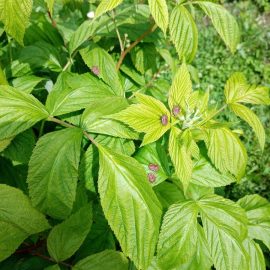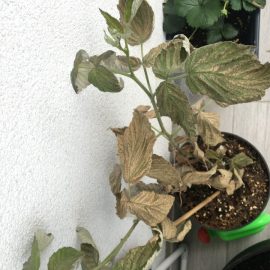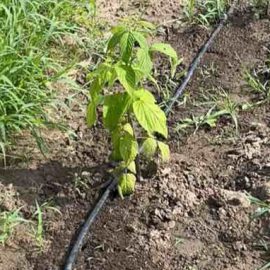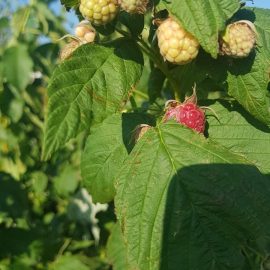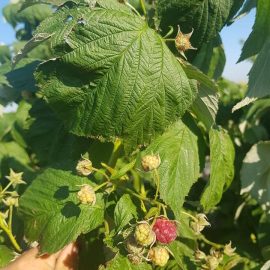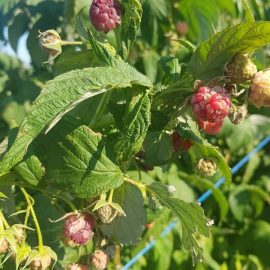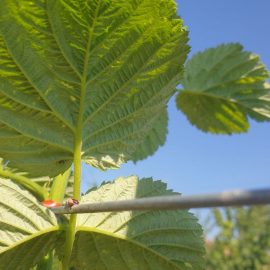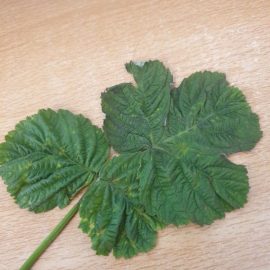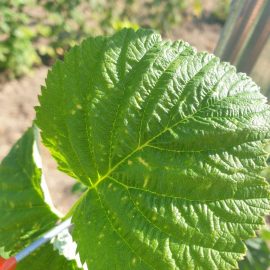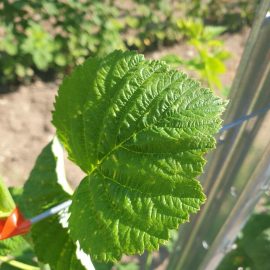Raspberry, planting, growing and harvesting

Raspberry (Rubus idaeus) is a fruit-bearing shrub that grows spontaneously in temperate countries. Raspberry plants are bushy, with creeping stems and straight, arching stems. It is cultivated because of its fruit, which has a specific aroma. The fruits are used in the food, pharmaceutical, and cosmetics industries. The popularity of this shrub is based on the complex content of its fruits, rich in organic acids, sugar, fragarine, vitamins (A, C, E, B1, B2, B5, B6), carotene, cyanine, salicylic acid, copper, calcium, iron, iodine, potassium, magnesium, and phosphorus.
Growing and fruiting particularities
The shrub has a branched root system that reaches into the soil to a depth of 30-40 cm. The raspberry has adventitious buds on the roots, which will form suckers. The young stems are erect or slightly inclined towards the top, forming shoots that will bear fruit. The lifespan of the stems is 2 years. The leaves are compound, with 3-5 leaflets, alternately arranged on the stems. The flowers are hermaphrodite and appear on the side shoots. The fruit is a red or yellowish polydruple, which detaches easily from the receptacle when ripe.
The remontant varieties of raspberry form flowers and fruit in the upper part of the stems from the first year, in autumn. The fruiting shoots dry out over the winter and in spring they must be removed. In the second year, the stems will fruit in the lower part in early summer.
Climate and soil requirements
Raspberry plants are light-demanding and under good light conditions, they produce quality fruit, form more fruit buds, and are more frost resistant. In terms of temperature, raspberries have average requirements. The shrub can withstand temperatures down to -20℃ if the stems are well-matured. The best results are obtained in areas where at least 700 mm of rainfall falls annually.
Water requirements are highest during stem growth and fruit ripening. Besides soil moisture, raspberries also require high atmospheric humidity, and if these conditions are not met, the shrub gives low yields and flavorless fruit. The soil should be rich in humus, permeable, and well aerated with a pH between 5.6 and 6.5.
Soil preparation
The soil preparation starts by removing all plants and plant debris from the preceding crop, and if the land is heavily infested with weeds, you can apply non-selective herbicides. Level the land, if necessary, taking into account the slope of the land.
Recommended products
-
You can find products on a different store
Change Store -
You can find products on a different store
Change Store -
You can find products on a different store
Change Store -
You can find products on a different store
Change Store -
You can find products on a different store
Change Store -
You can find products on a different store
Change Store -
You can find products on a different store
Change Store -
You can find products on a different store
Change Store -
You can find products on a different store
Change Store -
You can find products on a different store
Change Store -
You can find products on a different store
Change Store -
You can find products on a different store
Change Store -
You can find products on a different store
Change Store -
You can find products on a different store
Change Store -
You can find products on a different store
Change Store -
You can find products on a different store
Change Store -
You can find products on a different store
Change Store -
You can find products on a different store
Change Store -
You can find products on a different store
Change Store -
You can find products on a different store
Change Store -
You can find products on a different store
Change Store -
You can find products on a different store
Change Store -
You can find products on a different store
Change Store -
You can find products on a different store
Change Store
It is recommended to till the soil to a depth of 50-60 cm, to loosen the deep layers of the soil, immediately after clearing the land, followed by a deep plowing at 35-40 cm. If there is no possibility of tilling, you can only carry out deep plowing, followed by working with a disc.
The basic fertilization should be made with well-decomposed manure, and added in the planting pit. When tilling the soil, you may apply phosphorus and potassium fertilizers in variable quantities, depending on the soil supply. The mineral content of the soil can be determined by soil analysis.
After soil preparation, the next step is to make the pits, 30 x 30 x 30 cm, or open furrows, 30 cm deep. For a precise planting, the ground must be staked beforehand, which is used to mark out the future rows.
Choosing raspberry varieties
Choosing varieties is an important step for commercial plantations. They should be chosen according to the pedo-climatic conditions of the area, the technology applied, the harvesting method, and the fruit destination. It is recommended to plant several varieties to ensure better pollination and to stagger the harvest over a longer period. Varieties must be planted separately, depending on the ripening period.
Planting
Planting can be done in autumn, after leaf fall, or in early spring, immediately after the thaw. The main method of establishing the plantation is by root suckers. These should only be purchased from authorized nurseries and research stations. The planting material must be checked and diseased or poorly developed plants must be removed.
Before planting, the planting material should be trimmed by removing the injured roots and reducing the root system to a length of 15 cm. The roots should be placed in a slurry of yellow soil, cattle manure, and water. As raspberry roots dehydrate easily, they can be kept in a pot of water for a few hours before planting.
At the base of the pit add a mixture of 50% fertile soil (removed from the pit surface) + 50% well-decomposed manure. The roots should be placed flat on the layer at the bottom of the pit, covered with soil, and compacted. After planting, irrigate and make a 10-12 cm high soil mound. After the mounding, shorten the plants so that 3-4 buds remain above the soil layer (mounding).
For commercial plantations, are used distances of 2.5-3 m between rows and 0.3-0.5 m between plants per row. In the household system, is recommended the following planting scheme: 1,5-2 m between rows and 50-80 cm between plants per row, with a planting depth of 30 cm.
The rows should be planted north-south so the plants get enough light throughout the day.
Care works
In order to facilitate maintenance work and harvesting, it is recommended to trellis the raspberry plantation. An effective system consists of trellises and wires. The trellises should be placed 8 m apart and 60 cm deep and the wires should be attached to the trellises to support the shrubs. In the household system, you can use poles, on which you can tie the shrub stems.
Pruning
Raspberry pruning is relatively simple. For varieties that produce fruit only once, the best results are obtained when pruning is done in spring, in March-April.
Recommended products
-
You can find products on a different store
Change Store -
You can find products on a different store
Change Store -
You can find products on a different store
Change Store -
You can find products on a different store
Change Store -
You can find products on a different store
Change Store -
You can find products on a different store
Change Store -
You can find products on a different store
Change Store -
You can find products on a different store
Change Store -
You can find products on a different store
Change Store -
You can find products on a different store
Change Store -
You can find products on a different store
Change Store -
You can find products on a different store
Change Store -
You can find products on a different store
Change Store -
You can find products on a different store
Change Store -
You can find products on a different store
Change Store -
You can find products on a different store
Change Store -
You can find products on a different store
Change Store -
You can find products on a different store
Change Store -
You can find products on a different store
Change Store -
You can find products on a different store
Change Store -
You can find products on a different store
Change Store -
You can find products on a different store
Change Store -
You can find products on a different store
Change Store -
You can find products on a different store
Change Store
In the first year, the root suckers should be pruned in early spring, if planted in autumn. In the second year, choose 2-3 vigorous stems before the plants sprout, and shorten to 100-120 cm. Then, remove the rest of the stems to encourage the development of the root system and new rot suckers.
Raspberries form several stems each year, which can clump the bush and consume the plant’s resources, which is why pruning is necessary. In addition, overcrowding leads to low-quality fruit and encourages diseases and pests.
Starting with the third year after planting, in spring, remove the stems that have fruited in the previous year (they are easily visible because they are dry). Remove competing or very thin ones. Cut back one-year-old stems that are about to fruit at 140-160 cm.
Raspberries require a well-drained, weed-free soil.
For this reason, the interval between rows cannot be cultivated with other plants. Loosen the soil 2-3 times (10-12 cm) during the growing season to keep it clean. In the autumn, plow 18-20 cm deep. Along the rows, carry out 2-4 manual hoeing operations during the growing season to loosen the soil and destroy weeds.
You can apply specific herbicides if the soil is heavily infested with weeds. Attention!! During the first 2 years after planting do not use herbicides.
Recommended products
-
You can find products on a different store
Change Store -
You can find products on a different store
Change Store -
You can find products on a different store
Change Store -
You can find products on a different store
Change Store -
You can find products on a different store
Change Store -
You can find products on a different store
Change Store -
You can find products on a different store
Change Store -
You can find products on a different store
Change Store -
You can find products on a different store
Change Store -
You can find products on a different store
Change Store -
You can find products on a different store
Change Store -
You can find products on a different store
Change Store -
You can find products on a different store
Change Store -
You can find products on a different store
Change Store -
You can find products on a different store
Change Store -
You can find products on a different store
Change Store -
You can find products on a different store
Change Store -
You can find products on a different store
Change Store -
You can find products on a different store
Change Store -
You can find products on a different store
Change Store -
You can find products on a different store
Change Store -
You can find products on a different store
Change Store -
You can find products on a different store
Change Store -
You can find products on a different store
Change Store
Raspberry plantations can be successfully mulched with organic material or foil. This keeps soil moisture at a constant level and encourages rooting. You can use peat, compost, straw, or polythene foil. Organic materials should be incorporated into the soil in the autumn as a fertilizer. The spaces between the raspberry rows can be kept grassed.
The shrub’s health influences the plantation yield. Raspberries are attacked by several diseases and pests, which can damage the plantation irreversibly.
To reach maximum production capacity, raspberries need irrigation and additional fertilization. In areas where the water requirement (700 mm/year) is not provided by rainfall, apply 4-5 irrigations, with norms of 300-400 cubic meters/ha. Drip irrigation ensures efficient and localized water management and is the most recommended method.
Fertilization should be carried out before planting, according to soil preparation specifications. In fruit-bearing plantations, apply organic and chemical fertilizers locally along the rows every 2-3 years. Localized fertilization by drip irrigation is the most recommended method, using only water-soluble fertilizers.
Foliar fertilization is also recommended, to supplement root fertilization, depending on the plant’s needs and environmental conditions.
Recommended products
-
You can find products on a different store
Change Store -
You can find products on a different store
Change Store -
You can find products on a different store
Change Store -
You can find products on a different store
Change Store -
You can find products on a different store
Change Store -
You can find products on a different store
Change Store -
You can find products on a different store
Change Store -
You can find products on a different store
Change Store -
You can find products on a different store
Change Store -
You can find products on a different store
Change Store -
You can find products on a different store
Change Store -
You can find products on a different store
Change Store -
You can find products on a different store
Change Store -
You can find products on a different store
Change Store -
You can find products on a different store
Change Store -
You can find products on a different store
Change Store -
You can find products on a different store
Change Store -
You can find products on a different store
Change Store -
You can find products on a different store
Change Store -
You can find products on a different store
Change Store -
You can find products on a different store
Change Store -
You can find products on a different store
Change Store -
You can find products on a different store
Change Store -
You can find products on a different store
Change Store
Harvesting
The fruit ripens in stages over 20-30 days. Raspberries should be harvested in several stages, 3-4 days apart, in the morning or evening. Raspberries have a high perishability and under normal conditions, the fruit cannot be stored for more than a few days.



















































































































































































































































































































































































































































